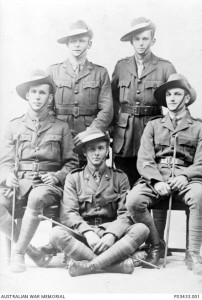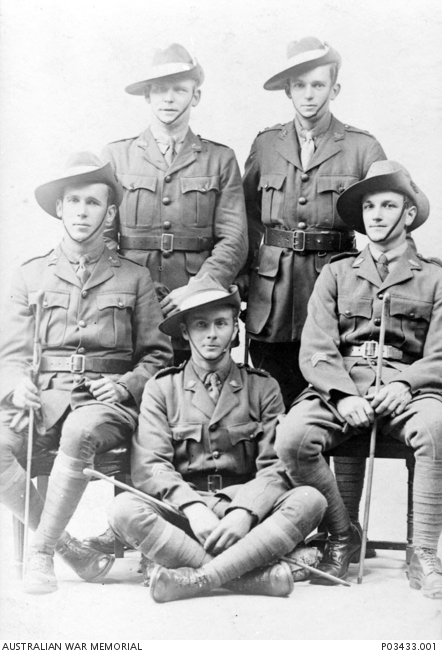
Five members of the 9th Field Company, Australian Engineers. Sergeant Herbert Velvin-Smith is seated on the right. Image courtesy Australian War Memorial.
Herbert Velvin-Smith was born in Orange in 1892 to John Smith and his wife Elizabeth Candy Smith (nee Velvin). A brother, Reginald, had been born the previous year; a sister, Doris, followed in 1896.
Herbert’s grandfather, John Velvin, was a 3rd generation master cabinet–maker who worked for Dalton Brothers store in Orange. He was Mayor of East Orange in 1898-9 and 1901 and, with his wife Elizabeth Anne, was instrumental in the establishment of the East Orange Post Office in Summer Street East, which opened in December 1901 and is still in operation.
Herbert spent his early years in Orange, then studied Agriculture at Hawkesbury Agricultural College in Richmond, Sydney.
‘HV’ as he became known, enlisted in the 1st AIF at Rosebery Park in Sydney on 21 March 1916. He was assigned to the 9th Field Company Engineers and sailed for France via Southampton on 21 November 1916. He was promoted to Lance Corporal in June 1917. On 8 April 1918 HV and Lance Corporal John James Wilson were mentioned in despatches and recommended for the Military Medal for their “heroic efforts” for their part in completing and maintaining a bridge across the Somme to allow withdrawal of allied troops. This feat was accomplished during ten hours of heavy bombardment. HV volunteered to remain behind to demolish the bridge should there be an enemy attack.
At the end of the war HV was selected to attend an Infantry Cadet Course in England. He was promoted to 2nd Lieutenant on 2 Jan 1919, then Lieutenant in April 1919.
Herbert returned to Australia on the Beltana in June 1919 with the 3rd Pioneer Battalion and settled in Batlow. He married Margaret Laing in 1929 and they had two sons and a daughter.
It was in Batlow that HV worked to make extraordinary and wide-reaching changes to the fruit-growing industry. These included the establishment of the cold-store industry and the development of co-operative fruit marketing. He was instrumental in the establishment of the “Mountain Maid” Cannery in Batlow. With the outbreak of WWII, HV facilitated and supported the Women’s Land Army in the Batlow district. In 1959 he was awarded an OBE “for services to the fruit and canning industries of Australia”.
Herbert Velvin-Smith died at Batlow in 1984. His wife and two sons predeceased him and all are buried at Batlow General Cemetery. His daughter, Ruth, aged 86, lives in Melbourne, Victoria.
Herbert’s bother, Reginald Arthur Smith, also served in WWI.
* Jane Silvester, 2015

